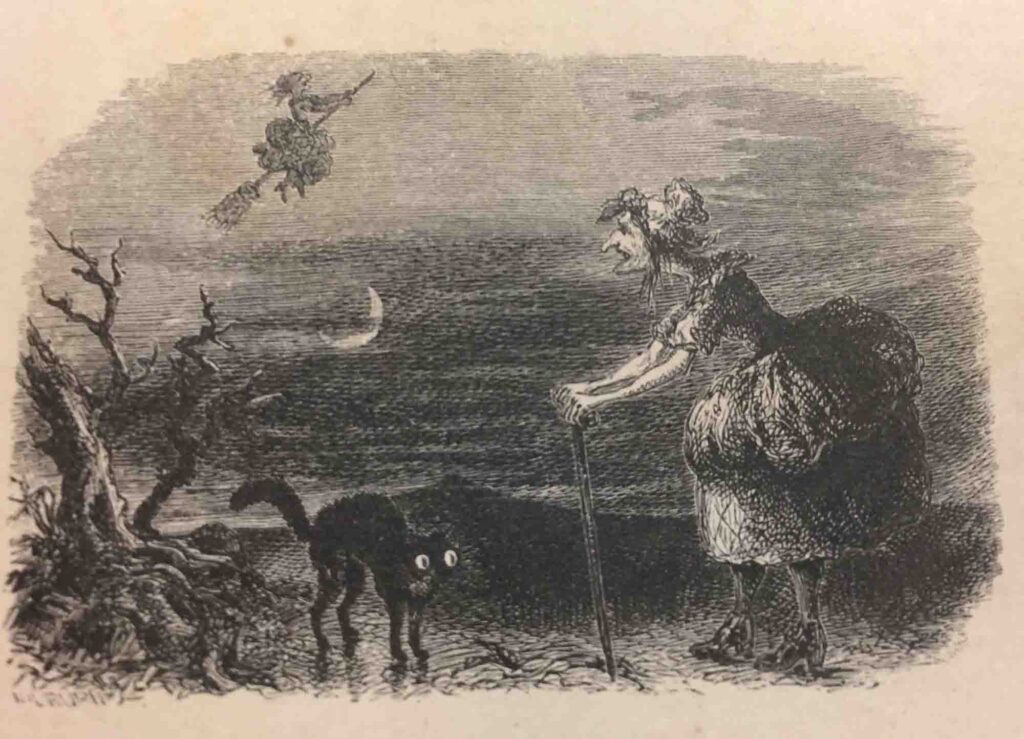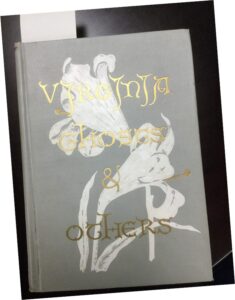
In addition to the various ghost-related books discussed in the previous post, the Galvin Rare Book Room is also home to a variety of materials pertaining to witchcraft. While the notion of “a witch” existed for hundreds of years, the witch trials in Europe and the British colonies in the Americas reached their peak between 1450 and 1750. Historians continue to study the many aspects of this phenomenon, exploring the varied cultural, social, religious, and political foundations that led to, and supported, the belief structures behind them. A quick search in the Boatwright Library catalog offers many options to read further on this topic.
The collections of materials on witchcraft in the Rare Book Room offer research opportunities into the topic, especially for students in Professor Sydney Watts’ History 199 course “Witches, Heretics, and Unbelievers: Orthodoxy & Heterodoxy in Western Europe, 1520-1800.” In this course, students focus on the basic elements of historical thinking and research by exploring the challenging concepts of the problem of truth and reality through the lens of witchcraft and heresy in early modern Europe. Examining primary and secondary sources are part of that research journey, and we always appreciate the opportunity to work with faculty, students, and staff on their research projects.
One of the primary texts defining the concept of a witch was the Malleus Maleficarum, or the Hammer of Witches, first published in 1486. Written by Catholic clergymen, the book functioned as a handbook for secular courts across Europe to assist in the identification, and eradication, of those deemed guilty of witchcraft. Its three sections use natural philosophy and theology to prove the existence of evil, illustrate how witches recruit protégés, offers remedies and reversals for the spellbound, and provides legal guidelines on how to run a witch trial. The Galvin Rare Book Room copy is a facsimile edition featuring an English translation of the 1486 text. This edition totaled 1275 numbered copies, of which this item is number 537; it was a gift from St. Paul’s Episcopal Church. (catalog link)
Earlier this year, we added a new work to the materials available to study the history of witchcraft, Del Congresso Notturnao delle lammie libri tre. (catalog link) Published in 1749, this item is a first edition printing highlighting arguments about practical magic and witchcraft coming from the Venetian Inquisition. Arguing against the more traditional viewpoints, the author Girolamo Tartarotti, claims that rather than demonic possession and satanic pacts, the behaviors tagged as magic relate more to medicinal herbs and potions and the fantasies and visions those concoctions produced. Even further, he suggests that the public spectacles of witch burnings fueled additional charges and outbreaks, noting that implementing less harsh measures might reduce the allegations by giving them less public attention. One notable chapter focuses specifically on werewolves, which Tartarotti believed were also the result of drug-induced visions.
Studying witchcraft in the American colonies focuses primarily on the trials held in Salem, Massachusetts between February 1692 and May 1693 when more than 200 people were accused and 19 executed by hanging after being found guilty of the charges. Several items in the collection relate directly to the happenings in Salem, including:
Cotton Mather, The Wonders of the Invisible World: being an account of the tryals of several witches lately executed in New-England; to which is added, A Farther Account of the tryals of the New-England Witches by Increase Mather. London: John Russell Smith, 1862 (catalog link)
Robert Calef, More Wonders of the Invisible World displayed: in Five Parts Boston: T. Bedlington, 1828. (catalog link)
Salem Witchcraft: Comprising More Wonders of the invisible world, collected by Robert Calef; and Wonders of the Invisible World, by Cotton Mather; together with notes and explanations by Samuel P. Fowler. Boston: W. Veazie, 1865 (catalog link)
R.R. Hinman, The Blue Laws of New Haven Colony, usually called blue laws of Connecticut; Quaker Laws of Plymouth and Massachusetts; blue laws of New York, Maryland, Virginia, and South Carolina. First record of Connecticut; interesting extracts from Connecticut records; cases of Salem witchcraft; charges and banishment of Rev. Roger Williams, and other interesting and instructive antiquities. Hartford: Case, Tiffany, 1838 (catalog link)
Other materials in the Rare Book Room also offer information on the study of witchcraft, including Sir Walter Scott, Letters on Demonology and Witchcraft. New York: Harper & Brothers, 1841 (catalog link). Witchcraft appears in other texts as well, including fictional works and in the artists’ books collection. Mary Johnson’s The Witch, published in 1914, is a novel set in 1600s England about a young English girl and a county physician who were part of the accused of sorcery and witchcraft (catalog link). Stories of witchcraft in colonial Virginia include James Bowyer’s The Witch of Jamestown, a story of colonial Virginia, published in 1890 (catalog link) in the Rare Book Room collection, while various depictions of the case of Grace Sherwood can be found in the circulating collection of the library. Even the historic children’s literature collection has two books on the topic: Tomie DePaola’s Strega Nona meets her match, published in 1993 (catalog link) and perhaps my personal favorite, Ib Spang Olsen’s The Marsh Crone’s Brew, translated by Virginia Allen Jensen in this 1960 version (catalog link).
Finally, one of the items in the artists’ books collections brings a contemporary experience to the study of witchcraft with the recently added work by Raeleen Kao, The Witch is Inside of Me. As indicated in the accompanying information sheet with the work, Kao describes it as a piece that “upends the nefariousness attributed to curiosity, sexuality, and disobedience in females and imbues the characters who raised me with power by embracing the corruptible, dual-faced nature within all of us.” (catalog link)
Oh, in case you were wondering when we’d get to the vampires in the title? There is indeed a work about vampires available. The Galvin Rare Book Room is home to a first edition, printed in 1746, of Augustin Calmet’s Dissertations sur les apparitions des anges, des demons & des espirits. Et sut les revenans et vampires De Hongrie, de Moheme, de Moravie, & de Silesie. This comprehensive study contains nearly 500 pages of analysis about sorcery and witchcraft, demons and angels, and perhaps his most controversial comments about vampires. As with some of the studies on witchcraft that attempt to reframe the conversation away from psychic or demonic elements and more towards physical aspects, Calmet’s opinions on vampires center on the effects of chemical substances in the soil on corpses. (catalog link)
Although under construction through Summer 2022, materials in the Galvin Rare Book Room are made available to UR faculty, staff, and students by appointment during this time.

